TP-Link TL-MR3040 User Manual

TL-MR3040
Portable 3G/3.75G Battery Powered
Wireless N Router
Rev: 1.0.0 1910010615

COPYRIGHT & TRADEMARKS
Specifications are subject to change without notice.  is a registered trademark of TP-LINK TECHNOLOGIES CO., LTD. Other brands and product names are trademarks or registered trademarks of their respective holders.
is a registered trademark of TP-LINK TECHNOLOGIES CO., LTD. Other brands and product names are trademarks or registered trademarks of their respective holders.
No part of the specifications may be reproduced in any form or by any means or used to make any derivative such as translation, transformation, or adaptation without permission from TP-LINK TECHNOLOGIES CO., LTD. Copyright © 2012 TP-LINK TECHNOLOGIES CO., LTD. All rights reserved.
http://www.tp-link.com
FCC STATEMENT
This equipment has been tested and found to comply with the limits for a Class B digital device, pursuant to part 15 of the FCC Rules. These limits are designed to provide reasonable protection against harmful interference in a residential installation. This equipment generates, uses and can radiate radio frequency energy and, if not installed and used in accordance with the instructions, may cause harmful interference to radio communications. However, there is no guarantee that interference will not occur in a particular installation. If this equipment does cause harmful interference to radio or television reception, which can be determined by turning the equipment off and on, the user is encouraged to try to correct the interference by one or more of the following measures:
•Reorient or relocate the receiving antenna.
•Increase the separation between the equipment and receiver.
•Connect the equipment into an outlet on a circuit different from that to which the receiver is connected.
•Consult the dealer or an experienced radio/ TV technician for help.
This device complies with part 15 of the FCC Rules. Operation is subject to the following two conditions:
1)This device may not cause harmful interference.
2)This device must accept any interference received, including interference that may cause undesired operation.
Any changes or modifications not expressly approved by the party responsible for compliance could void the user’s authority to operate the equipment.
Note: The manufacturer is not responsible for any radio or TV interference caused by unauthorized modifications to this equipment. Such modifications could void the user’s authority to operate the equipment.
I

FCC RF Radiation Exposure Statement
This equipment complies with FCC RF radiation exposure limits set forth for an uncontrolled environment. This device and its antenna must not be co-located or operating in conjunction with any other antenna or transmitter.
“To comply with FCC RF exposure compliance requirements, this grant is applicable to only Mobile Configurations. The antennas used for this transmitter must be installed to provide a separation distance of at least 20 cm from all persons and must not be co-located or operating in conjunction with any other antenna or transmitter.”
CE Mark Warning
This is a class B product. In a domestic environment, this product may cause radio interference, in which case the user may be required to take adequate measures.
National restrictions
This device is intended for home and office use in all EU countries (and other countries following the EU directive 1999/5/EC) without any limitation except for the countries mentioned below:
Country |
Restriction |
Reason/remark |
|
|
|
|
|
Bulgaria |
None |
General authorization required for outdoor use and |
|
public service |
|||
|
|
||
|
|
|
Outdoor use limited to 10 France mW e.i.r.p. within the band
2454-2483.5 MHz
Military Radiolocation use. Refarming of the 2.4 GHz band has been ongoing in recent years to allow current relaxed regulation. Full implementation planned 2012
Italy |
None |
If used outside of own premises, general authorization is |
|
required |
|||
|
|
||
|
|
|
|
Luxembourg |
None |
General authorization required for network and service |
|
supply(not for spectrum) |
|||
|
|
||
|
|
|
|
Norway |
Implemented |
This subsection does not apply for the geographical area |
|
within a radius of 20 km from the centre of Ny-Ålesund |
|||
|
|
||
|
|
|
|
Russian Federation |
None |
Only for indoor applications |
|
|
|
|
Note: Please don’t use the product outdoors in France.
II
Industry Canada Statement:
This device complies with RSS-210 of the Industry Canada Rules. Operation is subject to the following two conditions:
(1)This device may not cause harmful interference, and
(2)This device must accept any interference received, including interference that may cause undesired operation.
IMPORTANT NOTE:
Radiation Exposure Statement:
This equipment complies with Canada radiation exposure limits set forth for an uncontrolled environment. This equipment should be installed and operated with minimum distance 20cm between the radiator & your body.
Ce dispositif est conforme à la norme CNR-210 d’Industrie Canada applicable aux appareils radio exempts de licence. Son fonctionnement est sujet aux deux conditions suivantes:
(1)Le dispositif ne doit pas produire de brouillage préjudiciable, et
(2)Ce dispositif doit accepter tout brouillage reçu,y compris un brouillage susceptible de provoquer un fonctionnement indésirable.
NOTE IMPORTANTE:
Déclaration d’exposition aux radiations:
Cet équipement est conforme aux limites d’exposition aux rayonnements IC établies pour un environnement non contrôlé. Cet équipement doit être installé et utilisé avec un minimum de 20 cm de distance entre la source de rayonnement et votre corps.
Korea Warning Statements:
.
NCC Notice:
功率或變更原設計之特性及功能。
頻電機須忍受合法通信或工業、科學及醫療用電波輻射性電機設備之干擾。
III
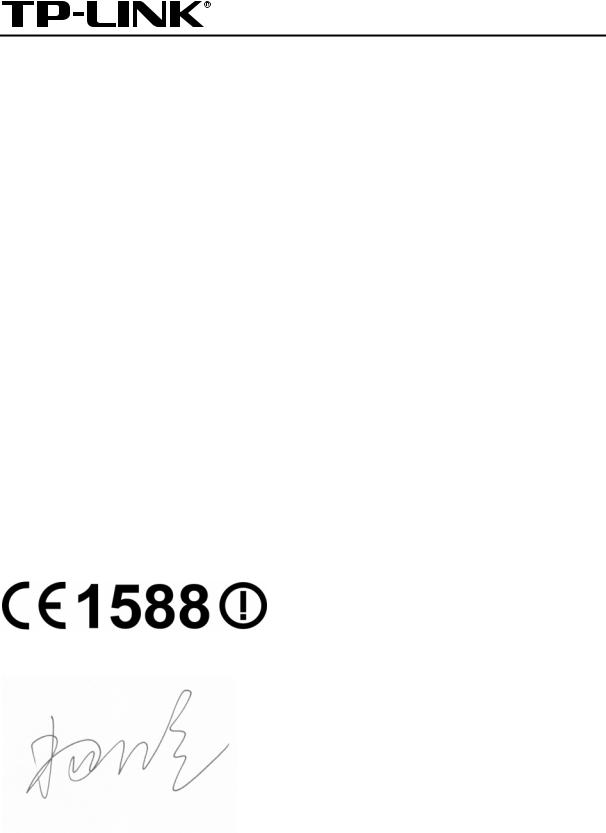
TP-LINK TECHNOLOGIES CO., LTD
DECLARATION OF CONFORMITY
For the following equipment:
Product Description: Portable 3G/3.75G Battery Powered Wireless N Router
Model No.: TL-MR3040
Trademark: TP-LINK
We declare under our own responsibility that the above products satisfy all the technical regulations applicable to the product within the scope of Council Directives:
Directives 1999/5/EC, Directives 2004/108/EC, Directives 2006/95/EC, Directives 1999/519/EC, Directives 2011/65/EU
The above product is in conformity with the following standards or other normative documents
ETSI EN 300 328 V1.7.1: 2006
ETSI EN 301 489-1 V1.8.1:2008& ETSI EN 301 489-17 V2.1.1:2009
EN 55022:2006 +A1:2007
EN 55024:1998+A1:2001+A2:2003
EN 61000-3-2:2006+A1:2009+A2:2009
EN 61000-3-3:2008
EN60950-1:2006+A11:2009+A1:2010
EN62311:2008
The product carries the CE Mark:
Person is responsible for marking this declaration:
Yang Hongliang
Product Manager of International Business
Date of issue: 2012
TP-LINK TECHNOLOGIES CO., LTD.
Building 24 (floors 1, 3, 4, 5), and 28 (floors 1-4) Central Science and Technology Park,
Shennan Rd, Nanshan, Shenzhen, China
|
|
CONTENTS |
|
Package Contents |
.......................................................................................................................... |
1 |
|
Chapter 1. |
Introduction................................................................................................................. |
2 |
|
1.1 |
Overview .................................................................................................of the Router |
2 |
|
1.2 |
Conventions ................................................................................................................. |
2 |
|
1.3 |
Main Features .............................................................................................................. |
2 |
|
1.4 |
Panel Layout ................................................................................................................ |
3 |
|
|
1.4.1 ................................................................................................ |
The Front Panel |
3 |
|
1.4.2 ................................................................................................ |
The Rear Panel |
4 |
Chapter 2. Connecting ...............................................................................................the Router |
5 |
||
2.1 |
System ..................................................................................................Requirements |
5 |
|
2.2 |
Installation ........................................................................Environment Requirements |
5 |
|
Chapter 3. Quick Installation .............................................................................................Guide |
6 |
||
3.1 |
Four Typical ..........................................................................................Working Mode |
6 |
|
3.2 |
PC configuration........................................................................................................... |
9 |
|
|
3.2.1 .......................................................................................... |
Connect to Network |
9 |
|
3.2.2 ....................................................................................... |
Router Configuration |
10 |
Chapter 4. Configuration—3G .............................................................................Router Mode |
25 |
||
4.1 |
Login .......................................................................................................................... |
|
25 |
4.2 |
Status ......................................................................................................................... |
|
25 |
4.3 |
Quick Setup................................................................................................................ |
26 |
|
4.4 |
Operation ..........................................................................................................Mode |
26 |
|
4.5 |
Network ...................................................................................................................... |
27 |
|
|
4.5.1 ............................................................................................... |
Internet Access |
27 |
|
4.5.2 ................................................................................................................... |
3G |
28 |
|
4.5.3 ............................................................................................................... |
WAN |
33 |
|
4.5.4 ..................................................................................................... |
MAC Clone |
43 |
|
4.5.5 ................................................................................................................. |
LAN |
43 |
4.6 |
Wireless ..................................................................................................................... |
44 |
|
|
4.6.1 ............................................................................................ |
Wireless Settings |
44 |
|
4.6.2 ............................................................................................ |
Wireless Security |
47 |
|
4.6.3 ................................................................................... |
Wireless MAC Filtering |
50 |
|
4.6.4 ......................................................................................... |
Wireless Advanced |
52 |
|
4.6.5 ........................................................................................... |
Wireless Statistics |
53 |
4.7 |
DHCP ......................................................................................................................... |
|
54 |
I
|
4.7.1 |
DHCP Settings ............................................................................................... |
54 |
|
4.7.2 |
DHCP Clients List ........................................................................................... |
56 |
|
4.7.3 |
Address Reservation ...................................................................................... |
56 |
4.8 |
Forwarding ................................................................................................................. |
57 |
|
|
4.8.1 |
Virtual Servers ................................................................................................ |
58 |
|
4.8.2 |
Port Triggering ................................................................................................ |
59 |
|
4.8.3 |
DMZ................................................................................................................ |
61 |
|
4.8.4 |
UPnP .............................................................................................................. |
62 |
4.9 |
Security ...................................................................................................................... |
63 |
|
|
4.9.1 |
Basic Security................................................................................................. |
63 |
|
4.9.2 |
Advanced Security.......................................................................................... |
65 |
|
4.9.3 |
Local Management ......................................................................................... |
66 |
|
4.9.4 |
Remote Management ..................................................................................... |
67 |
4.10 |
Parental Control ......................................................................................................... |
68 |
|
4.11 |
Access Control ........................................................................................................... |
71 |
|
|
4.11.1 |
Rule ................................................................................................................ |
71 |
|
4.11.2 |
Host ................................................................................................................ |
77 |
|
4.11.3 |
Target.............................................................................................................. |
79 |
|
4.11.4 |
Schedule......................................................................................................... |
81 |
4.12 Advanced Routing ...................................................................................................... |
82 |
||
|
4.12.1 |
Static Routing List........................................................................................... |
83 |
|
4.12.2 System Routing Table..................................................................................... |
84 |
|
4.13 Bandwidth Control ...................................................................................................... |
84 |
||
|
4.13.1 |
Control Settings .............................................................................................. |
85 |
|
4.13.2 |
Rules List........................................................................................................ |
85 |
4.14 IP & MAC Binding....................................................................................................... |
86 |
||
|
4.14.1 |
Binding Settings.............................................................................................. |
86 |
|
4.14.2 ARP List.......................................................................................................... |
88 |
|
4.15 Dynamic DNS............................................................................................................. |
89 |
||
|
4.15.1 Comexe.cn DDNS .......................................................................................... |
89 |
|
|
4.15.2 Dyndns.org DDNS .......................................................................................... |
90 |
|
|
4.15.3 No-ip.com DDNS ............................................................................................ |
90 |
|
4.16 System Tools .............................................................................................................. |
91 |
||
|
4.16.1 |
Time Settings.................................................................................................. |
92 |
|
4.16.2 |
Diagnostic....................................................................................................... |
93 |
|
4.16.3 |
Firmware Upgrade.......................................................................................... |
95 |
|
4.16.4 |
Factory Defaults ............................................................................................. |
96 |
II
|
4.16.5 |
Backup & Restore........................................................................................... |
96 |
|
4.16.6 |
Reboot ............................................................................................................ |
97 |
|
4.16.7 |
Password........................................................................................................ |
98 |
|
4.16.8 |
System Log..................................................................................................... |
98 |
|
4.16.9 |
Statistics ......................................................................................................... |
99 |
Chapter 5. Configuration—Wireless Router / WISP Mode..................................................... |
102 |
||
5.1 |
Login ........................................................................................................................ |
|
102 |
5.2 |
Status ....................................................................................................................... |
|
102 |
5.3 |
Quick Setup.............................................................................................................. |
104 |
|
5.4 |
Operation Mode........................................................................................................ |
104 |
|
5.5 |
Network .................................................................................................................... |
104 |
|
|
5.5.1 |
WAN ............................................................................................................. |
104 |
|
5.5.2 |
MAC Clone .................................................................................................... |
114 |
|
5.5.3 |
LAN................................................................................................................ |
115 |
5.6 |
Wireless .................................................................................................................... |
116 |
|
|
5.6.1 |
Wireless Settings........................................................................................... |
116 |
|
5.6.2 |
Wireless Security.......................................................................................... |
122 |
|
5.6.3 |
Wireless MAC Filtering ................................................................................. |
125 |
|
5.6.4 |
Wireless Advanced ....................................................................................... |
128 |
|
5.6.5 |
Wireless Statistics......................................................................................... |
129 |
5.7 |
DHCP ....................................................................................................................... |
|
130 |
|
5.7.1 |
DHCP Settings ............................................................................................. |
130 |
|
5.7.2 |
DHCP Clients List ......................................................................................... |
131 |
|
5.7.3 |
Address Reservation .................................................................................... |
132 |
5.8 |
Forwarding ............................................................................................................... |
133 |
|
|
5.8.1 |
Virtual Servers .............................................................................................. |
133 |
|
5.8.2 |
Port Triggering .............................................................................................. |
135 |
|
5.8.3 |
DMZ.............................................................................................................. |
137 |
|
5.8.4 |
UPnP ............................................................................................................ |
138 |
5.9 |
Security .................................................................................................................... |
139 |
|
|
5.9.1 |
Basic Security............................................................................................... |
139 |
|
5.9.2 |
Advanced Security........................................................................................ |
140 |
|
5.9.3 |
Local Management ....................................................................................... |
142 |
|
5.9.4 |
Remote Management ................................................................................... |
143 |
5.10 Parental Control ....................................................................................................... |
144 |
||
5.11 Access Control ......................................................................................................... |
147 |
||
|
5.11.1 |
Rule .............................................................................................................. |
147 |
III
|
5.11.2 |
Host .............................................................................................................. |
153 |
|
5.11.3 |
Target............................................................................................................ |
155 |
|
5.11.4 |
Schedule....................................................................................................... |
157 |
5.12 Advanced Routing .................................................................................................... |
158 |
||
|
5.12.1 |
Static Routing List......................................................................................... |
159 |
|
5.12.2 System Routing Table................................................................................... |
160 |
|
5.13 Bandwidth Control .................................................................................................... |
160 |
||
|
5.13.1 |
Control Settings ............................................................................................ |
161 |
|
5.13.2 |
Rules List...................................................................................................... |
161 |
5.14 IP & MAC Binding Setting ........................................................................................ |
162 |
||
|
5.14.1 |
Binding Settings............................................................................................ |
162 |
|
5.14.2 ARP List........................................................................................................ |
164 |
|
5.15 Dynamic DNS........................................................................................................... |
165 |
||
|
5.15.1 Comexe.cn DDNS ........................................................................................ |
165 |
|
|
5.15.2 Dyndns.org DDNS ........................................................................................ |
166 |
|
|
5.15.3 No-ip.com DDNS .......................................................................................... |
167 |
|
5.16 System Tools ............................................................................................................ |
168 |
||
|
5.16.1 |
Time Settings................................................................................................ |
169 |
|
5.16.2 |
Diagnostic..................................................................................................... |
170 |
|
5.16.3 |
Firmware Upgrade........................................................................................ |
172 |
|
5.16.4 |
Factory Defaults ........................................................................................... |
173 |
|
5.16.5 |
Backup & Restore......................................................................................... |
173 |
|
5.16.6 |
Reboot .......................................................................................................... |
174 |
|
5.16.7 |
Password...................................................................................................... |
175 |
|
5.16.8 |
System Log................................................................................................... |
175 |
|
5.16.9 |
Statistics ....................................................................................................... |
176 |
Chapter 6. |
Configuration—AP Mode ....................................................................................... |
179 |
|
6.1 |
Login ........................................................................................................................ |
|
179 |
6.2 |
Status ....................................................................................................................... |
|
179 |
6.3 |
Quick Setup.............................................................................................................. |
181 |
|
6.4 |
Operation Mode........................................................................................................ |
181 |
|
6.5 |
Network .................................................................................................................... |
181 |
|
6.6 |
Wireless ................................................................................................................... |
182 |
|
|
6.6.1 |
Wireless Settings.......................................................................................... |
183 |
|
6.6.2 |
Wireless Security.......................................................................................... |
190 |
|
6.6.3 |
Wireless MAC Filtering ................................................................................. |
198 |
|
6.6.4 |
Wireless Advanced ....................................................................................... |
200 |
IV
|
6.6.5 |
Wireless Statistics ......................................................................................... |
202 |
6.7 |
DHCP |
....................................................................................................................... |
202 |
|
6.7.1 ............................................................................................. |
DHCP Settings |
203 |
|
6.7.2 ......................................................................................... |
DHCP Clients List |
204 |
|
6.7.3 .................................................................................... |
Address Reservation |
205 |
6.8 |
System ............................................................................................................Tools |
206 |
|
|
6.8.1 .................................................................................................. |
Time Setting |
206 |
|
6.8.2 ..................................................................................................... |
Diagnostic |
208 |
|
6.8.3 ........................................................................................ |
Firmware Upgrade |
210 |
|
6.8.4 ............................................................................................ |
Factory Defaults |
211 |
|
6.8.5 .......................................................................................... |
Backup & Restore |
211 |
|
6.8.6 .......................................................................................................... |
Reboot |
212 |
|
6.8.7 ...................................................................................................... |
Password |
213 |
|
6.8.8 ................................................................................................... |
System Log |
213 |
|
6.8.9 ....................................................................................................... |
Statistics |
214 |
Appendix A: FAQ........................................................................................................................ |
|
217 |
|
Appendix B: Configuring .............................................................................................the PCs |
222 |
||
Appendix C: Security .......................................................................................................Mode |
226 |
||
Appendix C: Specifications....................................................................................................... |
228 |
||
Appendix D: Glossary................................................................................................................ |
229 |
||
Appendix E: Compatible .....................................................................3G/3.75G USB Modem |
231 |
||
V

TL-MR3040 Portable 3G/3.75G Battery Powered Wireless N Router
Package Contents
The following items should be found in your package:
¾TL-MR3040 Portable 3G/3.75G Battery Powered Wireless N Router
¾Power Adapter
¾Battery
¾USB Cable
¾Ethernet cable
¾Quick Installation Guide
¾Resource CD for TL-MR3040 Portable 3G/3.75G Battery Powered Wireless N Router, including:
•This Guide
•Other Helpful Information
) Note:
Make sure that the package contains the above items. If any of the listed items are damaged or missing, please contact your distributor.
-1-

TL-MR3040 Portable 3G/3.75G Battery Powered Wireless N Router
Chapter 1. Introduction
Thank you for choosing the TL-MR3040 Portable 3G/3.75G Battery Powered Wireless N Router.
1.1 Overview of the Router
TL-MR3040 from TP-LINK is a truly mobile wireless networking platform that when paired with a 3G USB modem, is able to broadcast a wireless signal at up to 150Mbps around a room, creating a mobile office or entertainment network for up to five devices to access the Internet simultaneously. The device is the ideal travel companion, with pocket-sized dimensions and powered by its own powerful internal 2000mAh battery, users can work or play for hours on end. The device is also incredibly easy to use, allowing users to rapidly set up an Internet connected wireless network in as little time as it takes to plug in their 3G USB router or WAN cable and when finished, simply place the device back in their pockets.
1.2 Conventions
The Router or TL-MR3040 mentioned in this guide stands for TL-MR3040 Portable 3G/3.75G Battery Powered Wireless N Router without any explanation.
1.3 Main Features
¾Travel size design, small enough to take on the road
¾Features a 2000mAh chargeable battery for maximum usage time
¾Supports 3G Router Mode, WISP Client Router Mode, Wireless Router Mode and AP Mode
¾One 10/100M Auto-Negotiation RJ45 Ethernet port, one USB 2.0 Port, one micro USB port
¾Compatible with IEEE 802.11b/g/n, IEEE802.3/3u
¾Compatible with UMTS/HSPA/EVDO USB 3G Modem
¾Compatible with iPad, iTouch, Android Phone, Kindle and majority portable WiFi devices
¾Wireless Lite N speed up to 150Mbps
¾Provides WEP, WPA/WPA2, WPA-PSK/WPA2-PSK authentication, TKIP/AES encryption security
¾Powered by laptop or Power Adapter with Low Power Consumption
¾Supports 3G/PPPoE/Dynamic IP/Static IP/PPTP/L2TP Cable Internet access
¾Supports VPN Pass-through, Virtual Server and DMZ Host
¾Supports UPnP, Dynamic DNS, Static Routing
-2-
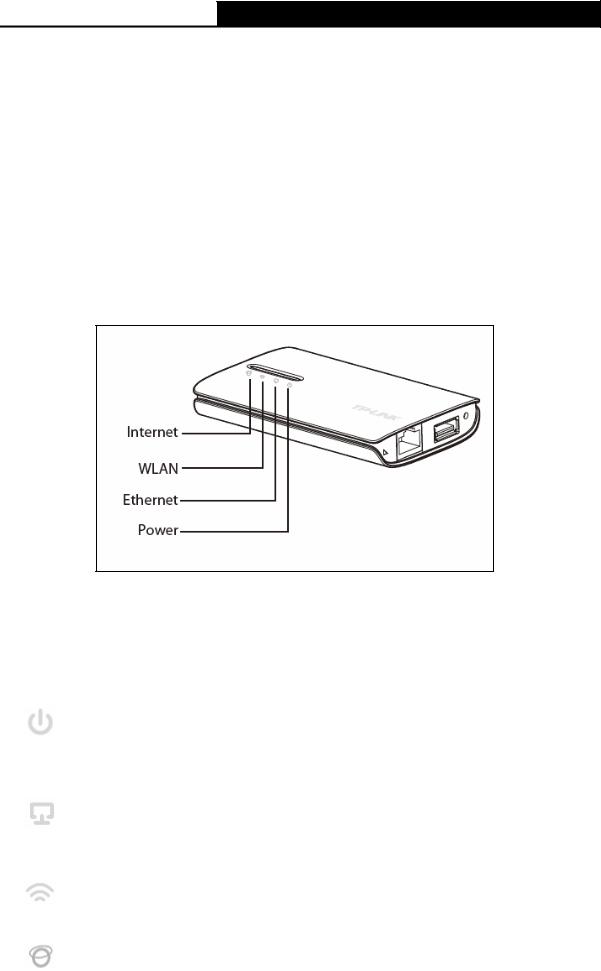
TL-MR3040 Portable 3G/3.75G Battery Powered Wireless N Router
¾Provides Automatic-connection and Scheduled Connection on certain time to the Internet
¾Built-in NAT and DHCP server supporting automatic and dynamic IP address IP address distribution
¾Connects Internet on demand and disconnects from the Internet when idle for PPPoE
¾Provides 64/128/152-bit WEP encryption security and wireless LAN ACL (Access ControlList)
¾Supports Flow Statistics
¾Supports firmware upgrade and Web management
1.4 Panel Layout
1.4.1The Front Panel
|
|
|
|
Figure 1-1 Front Panel sketch |
|
The Router’s LEDs are located on the front panel (View from bottom to top). |
|||||
|
|
|
|
|
|
|
Name |
|
Status |
|
Indication |
|
Power |
|
Solid (Green) |
|
The battery is full or the power supply is normal. |
|
|
Solid (Orange) |
|
The battery is being charged. |
|
|
|
|
|
||
|
|
|
Solid (Red) |
|
The battery power is low, you need to charge it. |
|
|
|
Flashing (Red) |
The battery is abnormal. |
|
|
Ethernet |
|
On |
|
A device is linked to the corresponding port but there is no |
|
|
|
activity. |
||
|
|
|
|
||
|
|
|
Flashing |
The Ethernet port is transferring data. |
|
|
|
|
Off |
No device is linked to the corresponding port. |
|
|
WLAN |
|
On |
|
The Wireless function is enabled. |
|
|
Flashing |
There is data being transferred through wireless. |
||
|
|
|
|||
|
|
|
Off |
The Wireless function is disabled. |
|
|
Internet |
|
Solid |
|
The 3G Modem/Card is identified. |
|
|
|
Flashing |
The Router is connected to the Internet and is transferring data. |
|
|
|
|
|
|
|
|
|
|
|
Table 1-1 The LEDs description |
|
-3-

TL-MR3040 Portable 3G/3.75G Battery Powered Wireless N Router
1.4.2The Rear Panel
Figure 1-2 Rear Panel sketch
The following parts are located on the rear panel (View from left to right).
¾Ethernet Port: This port can be LAN or WAN port depending on the working mode.
¾3G USB Port: This port is used to plug a 3G modem/card.
¾Reset: With the Router powered on, press and hold the Reset button for at least 10 seconds, and then the Router will restore to the default setting.
¾Micro USB Port: This port is used to connect the provided power adapter.
¾Power Switch: This switch is used to switch the power status of the Router.
-4-

TL-MR3040 Portable 3G/3.75G Battery Powered Wireless N Router
Chapter 2. Connecting the Router
2.1 System Requirements
¾3G/3.75G Mobile Broadband Internet Access Service (With a UMTS/HSPA/EVDO USB dongle)
¾PCs with a working Ethernet Adapter and an Ethernet cable with RJ45 connectors
¾TCP/IP protocol on each PC
¾Web browser, such as Microsoft Internet Explorer 5.0 , Netscape Navigator 6.0 or above
2.2 Installation Environment Requirements
¾Place the Router in a well ventilated place far from any heater or heating vent
¾Avoid direct irradiation of any strong light (such as sunlight)
¾Keep at least 2 inches (5 cm) of clear space around the Router
¾Operating Temperature: 0 ~40 (32 ~104 )
¾Operating Humidity: 10%~90%RH, Non-condensing
-5-
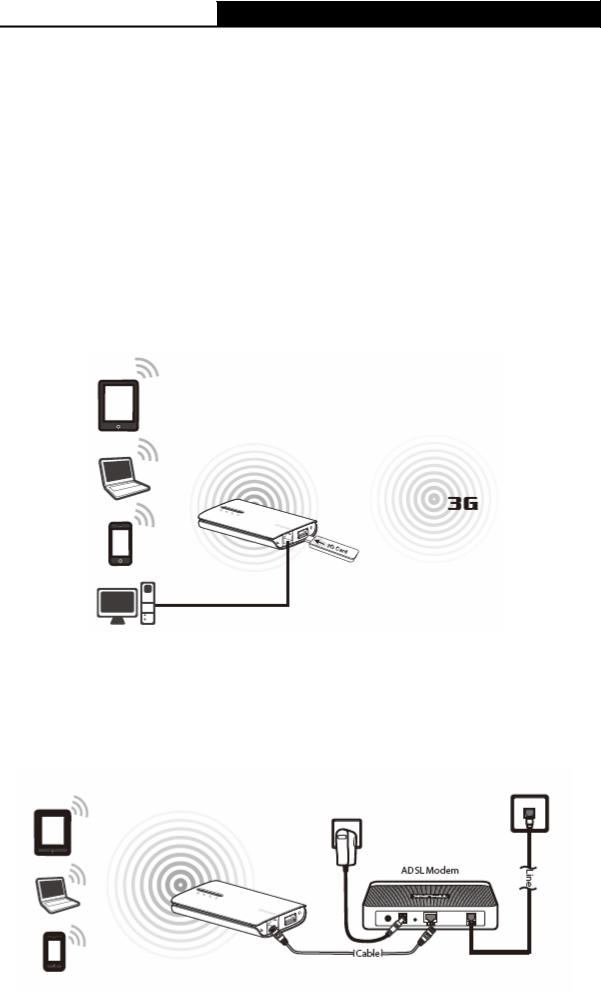
TL-MR3040 Portable 3G/3.75G Battery Powered Wireless N Router
Chapter 3. Quick Installation Guide
This chapter will show you how to configure the basic functions of your Portable 3G/3.75G Battery Powered Wireless N Router using Quick Setup Wizard within minutes.
3.1 Four Typical Working Mode
3G Router Mode
After inserting the 3G Card/Modem to the Router’s 3G USB port and configuring the Router, the Computers/WiFi Phone/Tablet PC could connect to the Internet. In this mode, the only wired port of the Router works as LAN. The connection between TL-MR3040 and the computer is shown as the figure below.
Wireless Router Mode
In this mode, the only wired port of the Router works as WAN. It can be connected to DSL/Cable Modem with an Ethernet cable. Computers/WiFi Phone/Tablet PC could connect to the device by only wireless way. DHCP server is enabled by default.
-6-
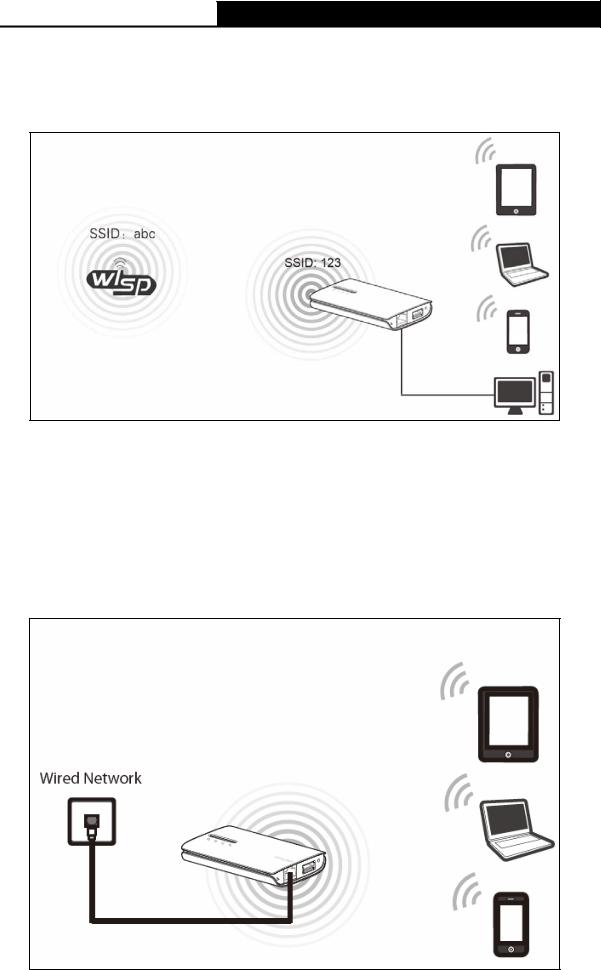
TL-MR3040 Portable 3G/3.75G Battery Powered Wireless N Router
WISP Client Router Mode
In this mode, the TL-MR3040 is wirelessly connected to the WISP (Wireless Internet Service Provider) and share the internet to multiple users.
Standard AP Mode
The Standard AP Mode includes the following four connection types: Access Point, Repeater, Bridge with AP and Client.
¾Access Point
In this mode, the TL-MR3040 is connected to a wired network and transforms the wired Internet access into wireless so that multiple users can share the Internet.
¾Repeater
-7-
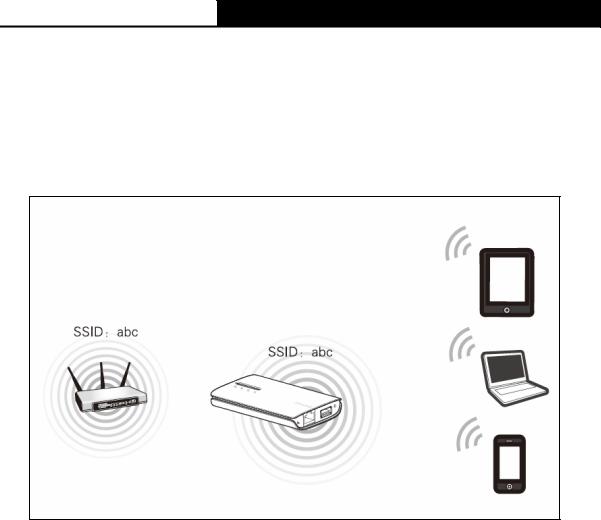
TL-MR3040 Portable 3G/3.75G Battery Powered Wireless N Router
TL-MR3040 is used to extend the range of wireless signal of the existing AP or wireless router. In this mode, the only wired port works as LAN. Computer could connect to the device by either wired or wireless way. The SSID of TL-MR3040should be the same as that of the device you repeat. To avoid the conflict of DHCP service with front-end devices, the DHCP server is default to be closed in this mode. If you want to log in the management page, please set your computer’s IP address manually.
¾Bridge with AP
TL-MR3040 in Bridge mode is used to extend the range of wireless signal of the existing AP or wireless router.
In this mode, the only wired port works as LAN. Computer could connect to the device by either wired or wireless way. To avoid the conflict of DHCP service with front-end devices, the DHCP server is default to be closed on this mode. If you want to log in the management page, please set your computer’s IP address manually.
-8-
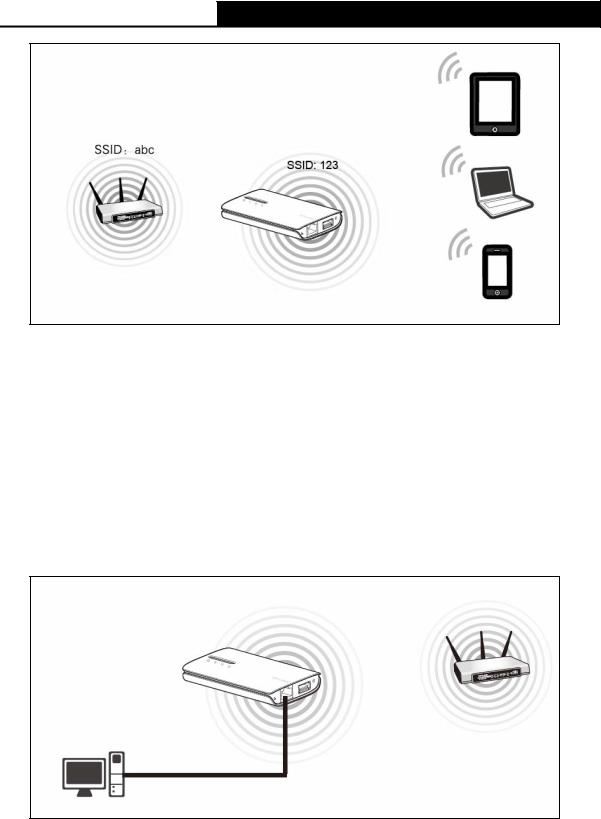
TL-MR3040 Portable 3G/3.75G Battery Powered Wireless N Router
¾Client
TL-MR3040 is used as a wireless network card to connect the wireless network signal or wireless router.
In this mode, the only wired port works as LAN. Computer could connect to the device by either wired or wireless way. To avoid the conflict of DHCP service with front-end devices, the DHCP server is default to be closed on this mode. If you want to log in the management page, please set your computer’s IP address manually.
3.2 PC configuration
Here we take Wireless Network Connection as an example. (You can also go to Local Area Connection to configure the PC for wired network connection, and then configure the router. If you need instructions as to how to do this, please refer to Appendix B: "Configuring the PC.")
1.For Windows XP, please go to Start → Settings → Control Panel → Network and Internet Connections → Network Connections; for Windows 7, please go to Start →
-9-
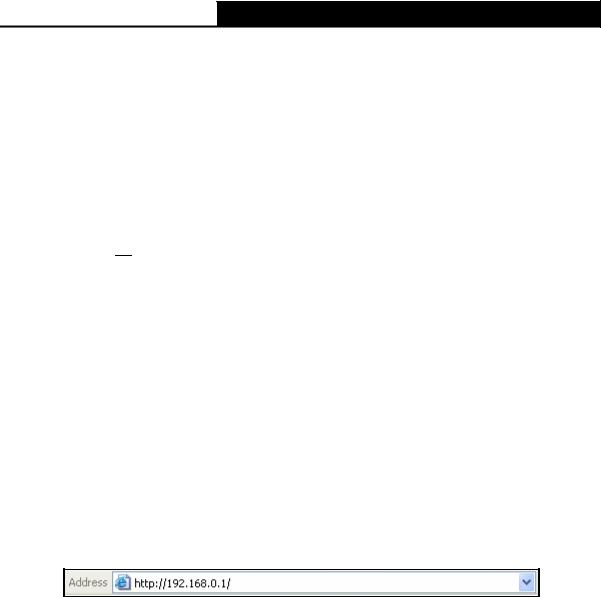
TL-MR3040 Portable 3G/3.75G Battery Powered Wireless N Router
Settings → Control Panel → View network status and tasks → Manage network connection. Right click Wireless Network Connection, and select Properties.
2.For Windows XP, double click Internet Protocol (TCP/IP) in the item list; for Windows 7, double click Internet Protocol Version 4 (TCP/IPv4).
3.Select “Obtain an IP address automatically” and “Obtain DNS server address automatically”. Click OK to finish the settings.
3.2.1Connect to Network
1.Click the icon  at the bottom of your desktop.
at the bottom of your desktop.
2.Click “Refresh network list”, and then select the network. Click Connect.
) Note:
The default SSID of the network is TP-LINK_POCKET_3040_xxxxxx. (The xxxxxx is the last six characters of the router’s MAC address.)
3. When Connected appears, you’ve successfully connected to the wireless network.
3.2.2Router Configuration
To access the configuration utility, open a web-browser and type the default address http://192.168.0.1 in the address field of the browser.
Figure 3-1 Login the Router
After a moment, a login window will appear, similar to the Figure 3-2. Enter admin for the User Name and Password, both in lower case letters. Then click the OK button or press the Enter key.
-10-
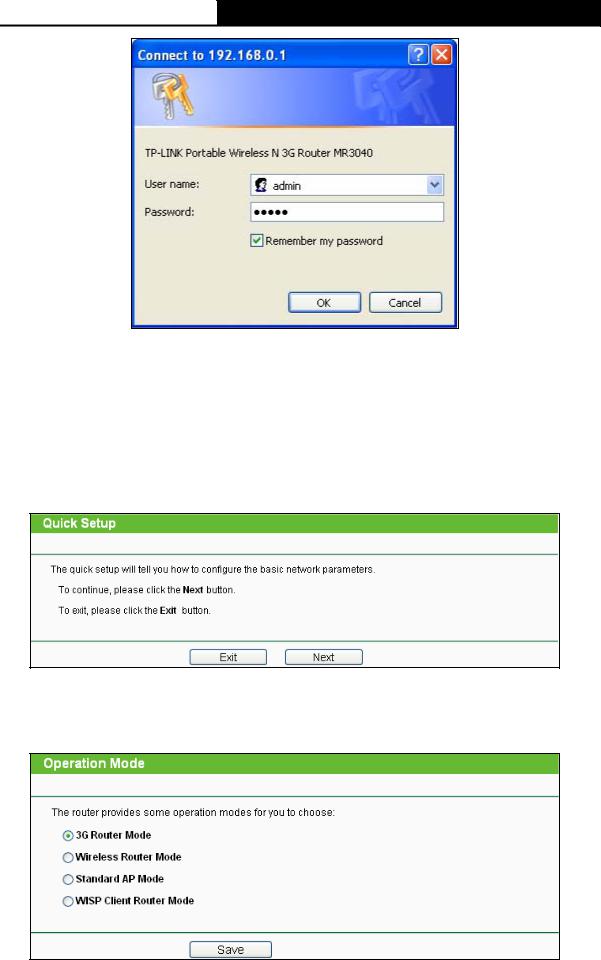
TL-MR3040 Portable 3G/3.75G Battery Powered Wireless N Router
Figure 3-2 Login Windows
) Note:
If the above screen does not pop-up, it means that your Web-browser has been set to a proxy. Go to Tools menu>Internet Options>Connections>LAN Settings, in the screen that appears, cancel the Using Proxy checkbox, and click OK to finish it.
After a successfully login, you can click the Quick Setup menu to quickly configure your Router, and then click Next.
Figure 3-3 Quick Setup
Choose the Operation Mode you need, and then click Next.
Figure 3-4 Operation Mode
-11-
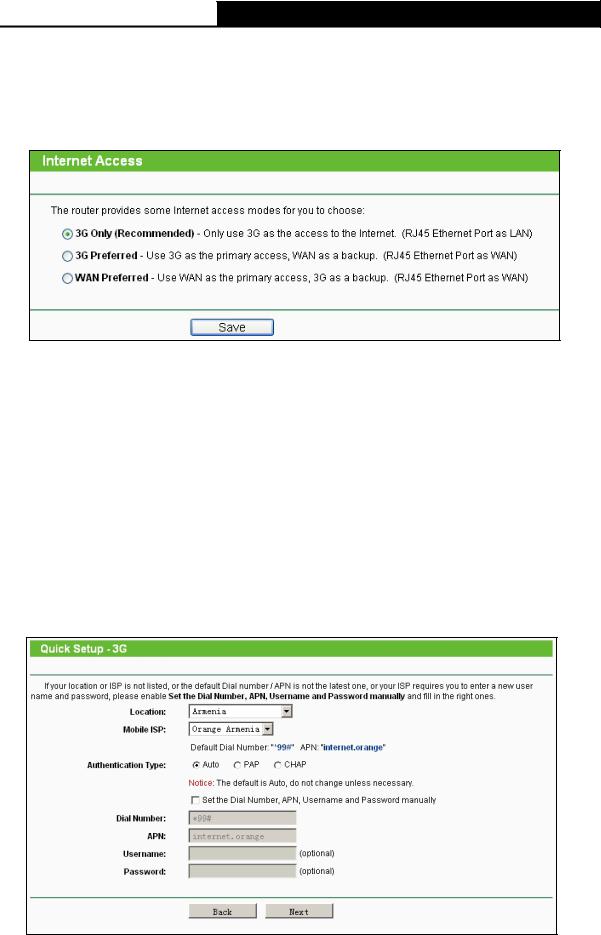
TL-MR3040 Portable 3G/3.75G Battery Powered Wireless N Router
Then you can configure the Wireless Settings according to the mode.
1.3G Router Mode
1.Choose the Internet Access type, and then click Next. Here we take 3G Only for example.
Figure 3-5 Quick Setup – Internet Access
¾3G Only - Only use 3G as the access to the Internet. The Ethernet port is used as LAN port.
¾3G Preferred - Use 3G as the primary access, WAN as a backup. The Ethernet port is used as WAN port.
¾WAN Preferred - Use WAN as the primary access, 3G as a backup. The Ethernet port is used as WAN port.
2.Select your location and Mobile ISP. If you don’t find your location and ISP in the pull-down menu, tick “Set the Dial Number, APN, Username and Password manually” to manually set them according to the information your 3G ISP provided. Then click Next.
Figure 3-6 Quick Setup – 3G
3.Set your wireless parameters. It’s recommended that you edit the following two items, and
-12-

TL-MR3040 Portable 3G/3.75G Battery Powered Wireless N Router
then click Next.
1)Create a unique and easy-to-remember Wireless Network Name.
2)Select WPA-Personal/WPA2-Personal under Wireless Security and enter a password in the field.
Figure 3-7 Quick Setup – Wireless
4.Click Reboot to make the settings take effect.
Figure 3-8 Quick Setup – Finish
) Note:
After the rebooting, please reconnect to the network according to 3.2.1Connect to Network. If Wireless Security is enabled, you need to enter the password you’ve just set to successfully finish the connecting.
2.Wireless Router Mode
1.Choose your WAN Connection type and click Next to continue.
-13-
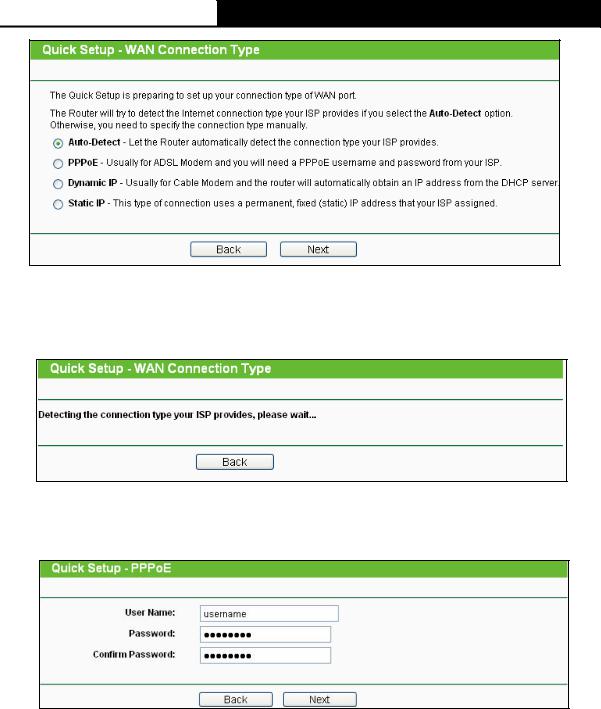
TL-MR3040 Portable 3G/3.75G Battery Powered Wireless N Router
Figure 3-9 Quick Setup – WAN Connection Type
¾If Auto-Detect is chosen, the router will detect the Internet connection type provided by your ISP automatically.
Figure 3-10 Quick Setup – Auto Detect
¾If the connection type is PPPoE, the next screen will appear as shown in Figure 3-11.
Figure 3-11 Quick Setup – PPPoE
zUser Name and Password - Enter the User Name and Password provided by your ISP. These fields are case sensitive. If you have difficulty with this process, please contact your ISP.
zConfirm Password - Re-enter the password provided by your ISP to ensure the Password you entered is correct. If the Password is different from the Confirm Password, the screen will appear as shown below. Click OK, and re-enter the Password and Confirm Password.
-14-
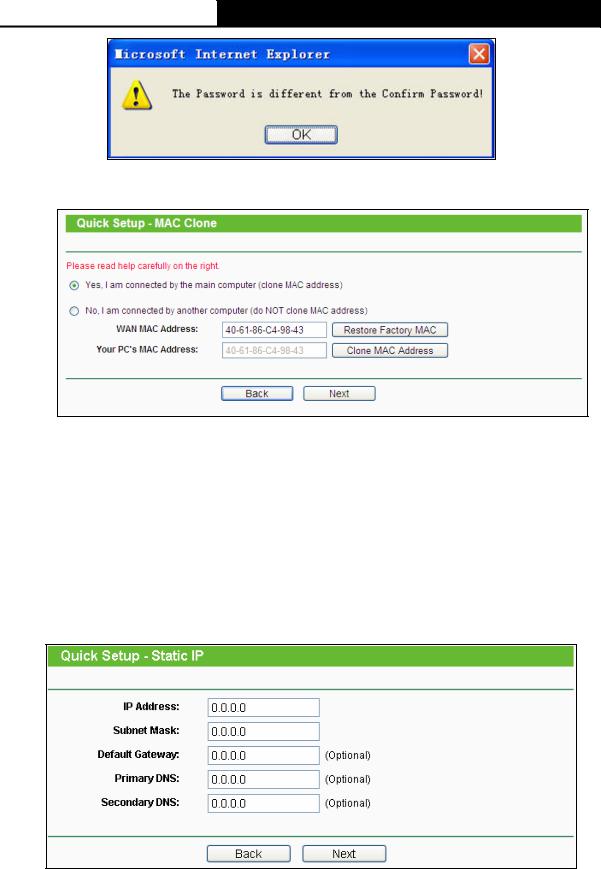
TL-MR3040 Portable 3G/3.75G Battery Powered Wireless N Router
¾If the connection type is Dynamic IP, the next screen will appear as shown in Figure 3-12.
Figure 3-12 Quick Setup – MAC Clone
zIf you are visiting the Router from the main computer, please select Yes, and then click Clone MAC Address.
zIf you are visiting the Router from another computer, rather than the main computer, please select No, and then enter the main computer’s MAC in the field
WAN MAC Address.
¾If the connection type detected is Static IP, the next screen will appear as shown in Figure 3-13.
Figure 3-13 Quick Setup - Static IP
zIP Address - This is the WAN IP address seen by external users on the Internet (including your ISP). Enter the IP address into the field.
-15-
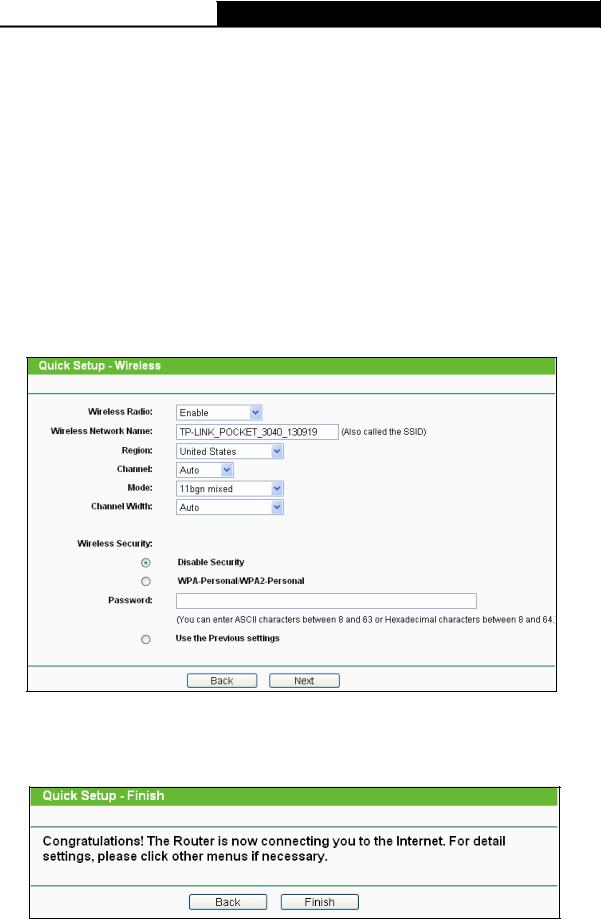
TL-MR3040 Portable 3G/3.75G Battery Powered Wireless N Router
zSubnet Mask - The Subnet Mask is used for the WAN IP address, it is usually 255.255.255.0.
zDefault Gateway - Enter the gateway IP address into the box if required.
zPrimary DNS - Enter the DNS Server IP address into the box if required.
zSecondary DNS - If your ISP provides another DNS server, enter it into this field.
2.Click Next to continue, the Wireless settings page will appear as shown in Figure 3-14. Set your wireless parameters. It’s recommended that you edit the following two items, and then click Next.
1)Create a unique and easy-to-remember Wireless Network Name.
2)Select WPA-Personal/WPA2-Personal under Wireless Security and enter a password in the field.
Figure 3-14 Quick Setup – Wireless
5.Click Reboot to make the settings take effect.
Figure 3-15 Quick Setup – Finish
-16-
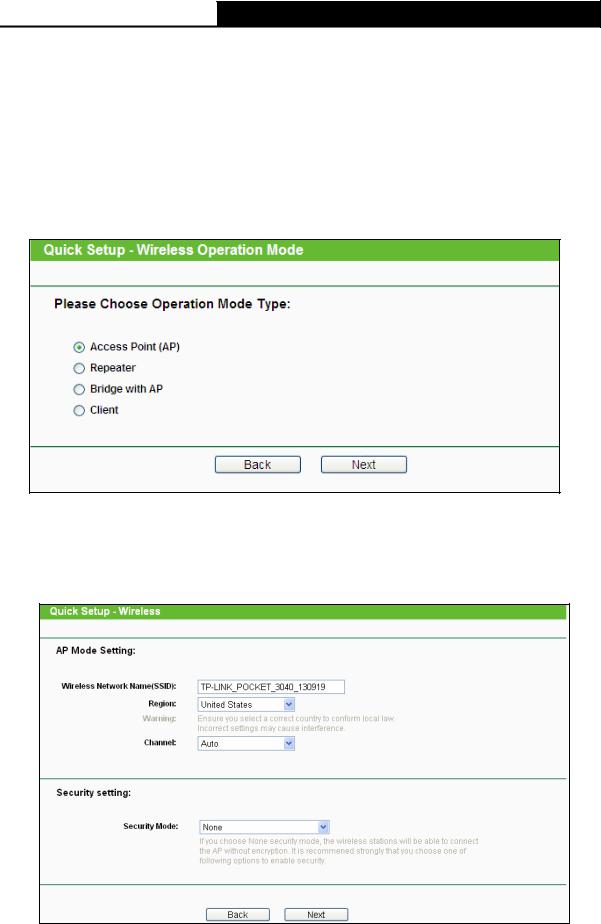
TL-MR3040 Portable 3G/3.75G Battery Powered Wireless N Router
) Note:
After the rebooting, please reconnect to the network according to 3.2.1Connect to Network. If Wireless Security is enabled, you need to enter the password you’ve just set to successfully finish the connecting.
3.Standard AP Mode
1.Choose the Wireless Operation Mode Type and click Next.
Figure 3-16 Quick Setup – Wireless Operation Mode
¾If you choose Access Point (AP), the next screen will appear as shown in Figure 3-17. This operation mode allows wireless stations to access.
Figure 3-17 Quick Setup – AP
zWireless Network Name (SSID) - Enter a value of up to 32 characters. The same Name (SSID) must be assigned to all wireless devices in your network. The
-17-
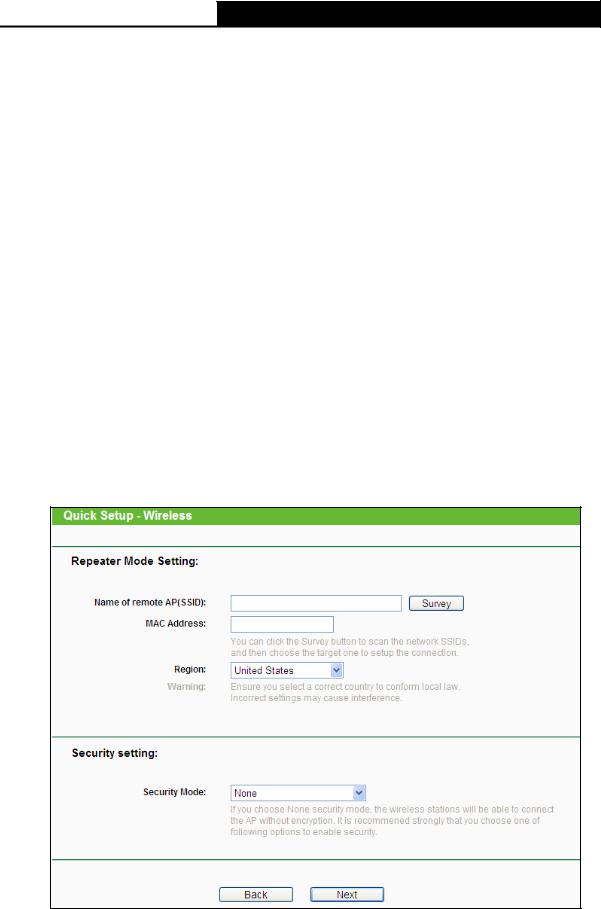
TL-MR3040 Portable 3G/3.75G Battery Powered Wireless N Router
default SSID is set to be TP-LINK_POCKET_3040_xxxxxx (xxxxxx indicates the last unique six characters of each Router's MAC address), which can ensure your wireless network security. But it is recommended strongly that you change your networks name (SSID) to a different value. This value is case-sensitive. For example, MYSSID is NOT the same as MySsid.
zRegion - Select your region from the pull-down list. This field specifies the region where the wireless function of the Router can be used. It may be illegal to use the wireless function of the Router in a region other than one of those specified in this filed. If your country or region is not listed, please contact your local government agency for assistance.
zChannel - This field determines which operating frequency will be used. It is not necessary to change the wireless channel unless you notice interference problems with another nearby access point. If you select auto, then the AP will select the best channel automatically.
zSecurity Mode – Please refer to the Appendix C: Security Mode.
¾If you choose Repeater, the next screen will appear as shown in Figure 3-18. In Repeater mode, the AP with WDS disabled will relays data to an associated root AP. AP function is enabled meanwhile. The wireless repeater relays signal between its stations and the root AP for greater wireless range. Please input the MAC address of root AP in the field "MAC Address".
Figure 3-18 Quick Setup – Repeater
-18-
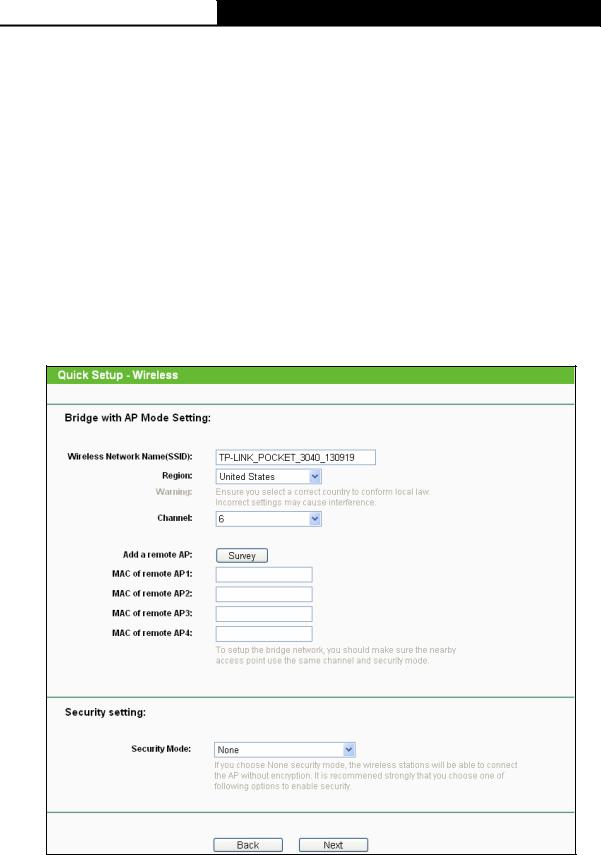
TL-MR3040 Portable 3G/3.75G Battery Powered Wireless N Router
zName of remote AP (SSID) - Enter the name of a remote AP (also called the SSID) that you want to access. Click the Survey button behind it, you can choose one of searching results to fill in this field.
zMAC Address - Enter the MAC address of AP that you want to access. When you use the survey function to fulfill the Name of remote AP (SSID), this field will be filled in automatically.
zRegion - This field determines which operating frequency will be used. To achieve more information, you can read the same glossary in Access Point part.
zSecurity Mode – Please refer to the Appendix C: Security Mode.
¾If you choose Bridge with AP, the next screen will appear as shown in Figure 3-19. This operation mode bridges the AP and up to 4 APs also in bridge mode to connect two or more wired LANs.
Figure 3-19 Quick Setup – Bridge with AP
zWireless Network Name (SSID) - Enter a value of up to 32 characters. To achieve more information, you can read the same glossary in Access Point part.
zRegion - This field determines which operating frequency will be used. To achieve more information, you can read the same glossary in Access Point part.
-19-
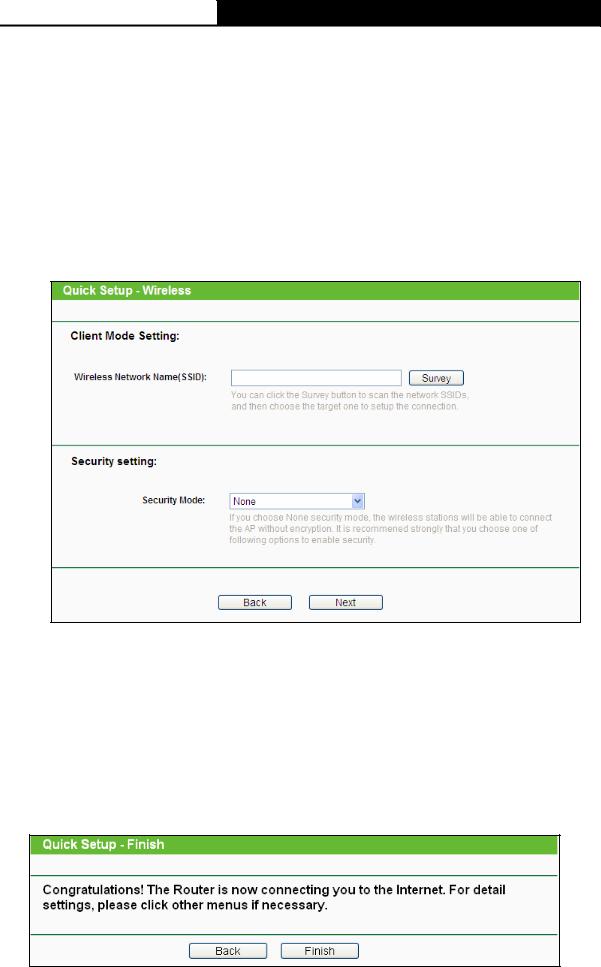
TL-MR3040 Portable 3G/3.75G Battery Powered Wireless N Router
zChannel - This field determines which operating frequency will be used. To achieve more information, you can read the same glossary in Access Point part.
zAdd a remote AP - Click the Survey button to fill in the MAC of remote AP (1-4) field.
zMAC of remote AP (1-4) - Enter the MAC address of AP that you want to access.
zSecurity Mode – Please refer to the Appendix C: Security Mode.
¾If you choose Client, the next screen will appear as shown in Figure 3-20. This operation mode bridges the AP and up to 4 APs also in bridge mode to connect two or more wired LANs.
Figure 3-20 Quick Setup – Client
zWireless Network Name (SSID) - Enter a value of up to 32 characters. Click the Survey button behind it, you can choose one of searching results to fill in this field.
zSecurity Mode – Please refer to the Appendix C: Security Mode.
2.Click Next and you will see the page as shown in Figure 3-21. Click Reboot to reboot the router and make the settings take effect.
Figure 3-21 Quick Setup – Finish
-20-
